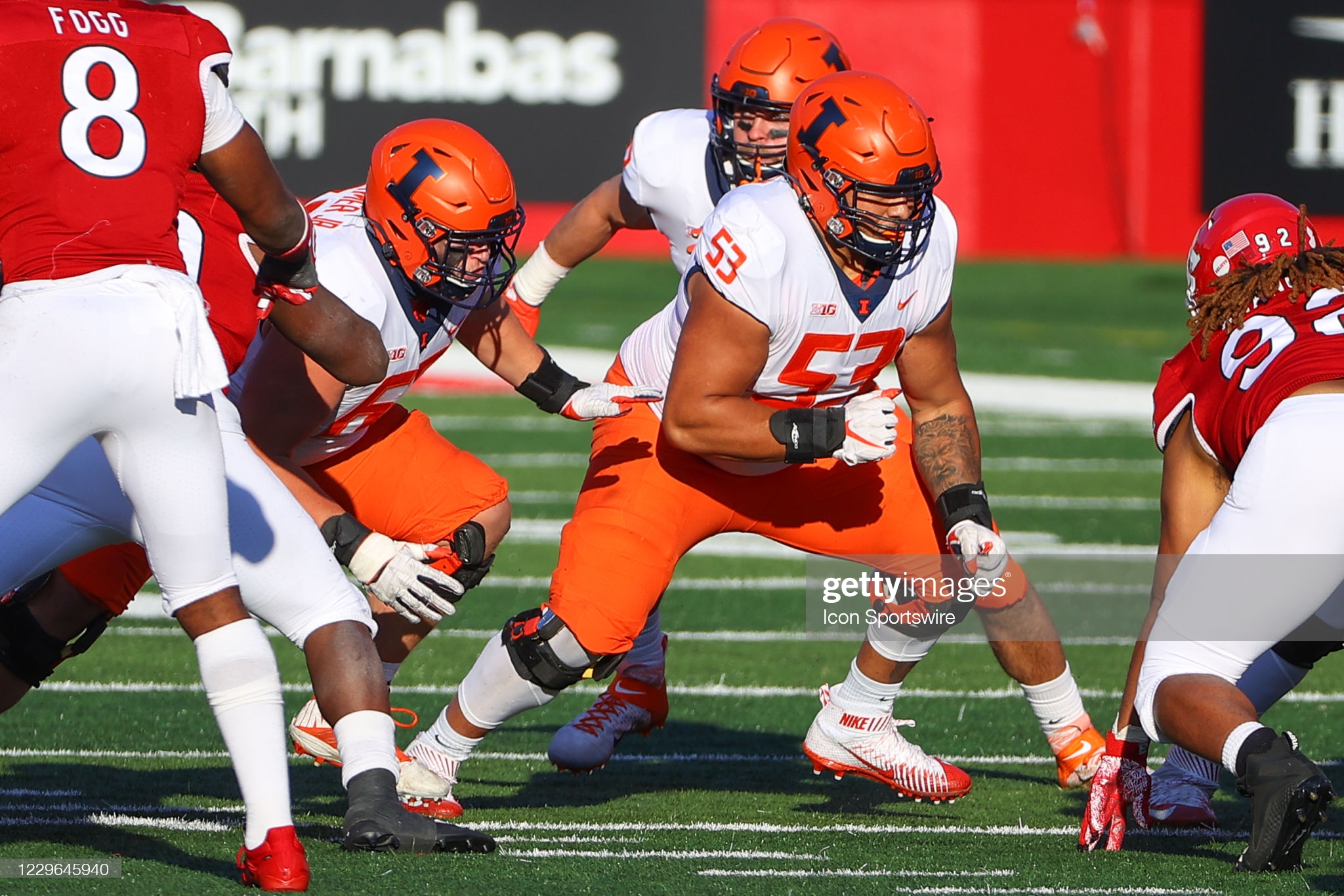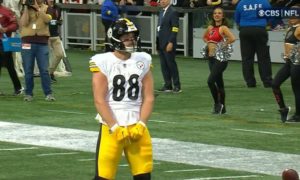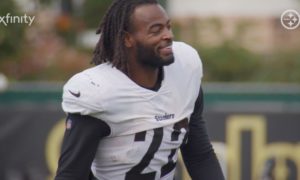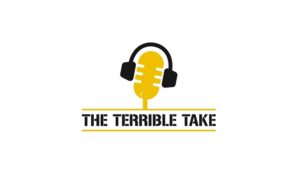First Things First
I hate the basic idea of handing out grades to judge a recent draft. It’s wrong at the very core, because it assumes that we amateurs are the teachers and the professionals our students. That’s bass-ackwards, folks! Kevin Colbert makes plenty of errors. Fewer than most, which is why he’s so well-respected, but he isn’t foolproof. That said, he is always rational. When Colbert does something unusual or surprising, I know he had a reason. It’s on me to ask, “What could explain this since I know it makes sense from his POV?”
This year’s draft creates a few questions along those lines:
- Why a running back in Round 1? Don’t the analytics say that’s a bad idea?
- Why pass over a center or a tackle in Round 2 in order to pick a tight end?
- Why go with four — four! — picks for the offense before making a single one for the defense?
- Why Kendrick Green in Round 3 instead of a different center?
- Why OT Dan Moore Jr. at #128 instead of a different tackle?
- Why choose Buck ILB Buddy Johnson at #140 instead of a defensive back or edge rusher?
- Why did the Steelers spend a 2022 Round 4 pick to buy a 2021 Round 5 pick, and then use it on a defensive lineman? Wasn’t that one of the positions we expected the team to ignore?
Then, at a more general level that interweaves with those, we need to ask:
- What lessons can we learn about Kevin Colbert’s approach to the draft?
- What lessons can we glean about the Steelers’ depth and lineup?
Those questions are where we’re going to end up, but the frame has to be a comparison to what we thought going in, and how that was reflected in our 2021 Steelers Big Board rankings.
How Did The Board Hold Up?
The short answer is, “better than usual.” It’s always hard to evaluate the Big Board after the draft because the grades aren’t really ours. They start as a consensus opinion from across the Internet. You and I bear no blame if those basic grades are off the mark. Our addition comes in the form of modifying that consensus to reflect a Steeler-specific lens. That’s the part we can critique.
This year’s draft predictions proved to be pretty darned accurate. The guys we expected to go early did go early, with only a few minor surprises like OT Alex Leatherwood rising to #17 overall after earning an early second consensus grade, and pre-draft Round 1 prospects like OT Teven Jenkins, OT Samuel Cosmi, and ILB Jeremiah Owusu-Koramoah falling to Round 2. That’s fewer aberrations than we usually see, and they weren’t as big as I’ve grown used to.
That accuracy may owe more to COVID-19 than unusually good evaluations, however. The small school and mid-level prospects who typically upset the apple cart lost a lot of their chances to do so because teams couldn’t do all the research needed to outweigh the question marks. Same thing for the young men who opted out. All of that shrank the pool of elite and almost-elite prospects, and made our collective hit rate seem higher than usual. The pattern continued throughout the draft, as we’ll discuss in a bit more detail below.
The more interesting lessons come from the Steelers’ picks, and our Steeler-specific discounts. That gets us to those questions we listed above.
Lesson #1 – The Steelers leadership responds to getting embarrassed, and Art Rooney is the guidepost to figure that out.
Pittsburgh’s 2020 running game was a disgrace. Full stop. The team came in last in almost every category, seemed helpless after James Conner’s annual injury bug arrived, and only got worse as the season went on. This city prides itself on a hard-nosed defense and a punch-you-in-the-nose offense. December and January saw our team trying to get by with a genteel finesse game of quick passes and screens.
It wasn’t Steelers Football. It was a poor man’s attempt to ape the West Coast offense or the old run-and-shoot. It was a disgrace.
Most fans put the blame squarely on the offensive line. I am less specific. IMHO, the blame stretches well beyond the offensive line, and it doesn’t end at Randy Fichtner’s door, either. Football is the ultimate team game, and this was a team-level failure.
No line opens college-level holes in the NFL. Professional teams call it a win when the line occupies enough defenders to leave the running back with a one-on-one. NFL backs need to win those matchups. Some do it by running over the defender, some go through him, some make juke him, and some are just fast enough to outrace him; but somehow, the RB needs to either win that one-on-one, or cede his snaps to someone else who will. James Conner managed to do that, but couldn’t stay healthy. Benny Snell did not. Anthony McFarland Jr. could not even earn enough snaps to legitimately say he failed.
That forced the team to “replace” actual runs with short passes, which narrowed Big Ben’s focus so much that he started to miss all the opportunities downfield. Even worse, opponents started doing to Pittsburgh what we expect our team to do to them. The Steelers got Steelered. It was humiliating, and we obviously weren’t the only ones to feel that shame. Everyone knew that improving the run game was going to be job #1 for the offseason.
I have seen a lot of fans say that the orders came down from the top, with Art Rooney saying “jump,” and the staff responding, “How high?” I see that as an insult to everyone involved. These are all grown men, and deservedly proud of both their expertise and accomplishments. I don’t see Colbert or Tomlin kowtowing to anyone, nor needing anyone’s help to feel the shame of last year’s flaws.
As for Mr. Rooney, does anyone really believe he’s the sort of dictatorial idiot who forms his opinions before talking with his in-house experts and getting the full story? I watched those games just as you did, and just as he did. My reaction went along these lines: “WTF are these people doing with this sorry excuse for a run game, and why can’t they fix it?!” I assume you all felt the same way. The difference between us and Mr. Rooney is this: We asked those questions to the air, but he asked them to Colbert & Tomlin. And he no doubt heard the actual reasons and explanations. “Explanations,” not “excuses.”
So I do not believe for a second that Art Rooney issued commands and his minions scurried to obey. But I am convinced that Art Rooney is part of Team Steelers, not a passive bystander, and that his role includes speaking to the public about what the brain trust collectively “feels.” Kevin Colbert plays his cards close to his chest, and tells us how the Steelers view each draft from the clusters and trends point of view. Coach Tomlin speaks to his players and staff even when he’s talking to us. He may be looking at you, me, or XYZ reporter, but he’s really talking to them. Mr. Rooney is the one who admits things like, “This running game clearly can’t be tolerated,” and tells us what to expect as areas of focus.
Why pick a running back in Round 1?
Job #1 of the 2021 offseason came down to one basic priority: Fix the run game. We all knew that. But how? From the draft POV, that priority forced the team to target (1) a running back who could win where Snell, McFarland, and the injured Conner could not; (2) a center to replace the retired Maurkice Pouncey; (3) a tight end to replace the injured/retired Vance McDonald; and (4) an offensive tackle to compete with or replace Chuks Okorafor and Zach Banner. But in what order?
Take a bow, friends. We pretty much nailed this one. When the process began, we focused on the OT’s for Round 1, with a RB penciled in for Round 2. As it moved forward we began to realize that the class simply didn’t contain any Round 2 backs. There were bargains galore in 2020 because that class had tremendous depth. Teams could afford to wait. Not so this year. Only two Round 1 talents existed in 2021, plus a single player who sat on the fringe. Supply and demand forced everyone’s hand. If you wanted a running back, you had to pay the full retail price. Waiting would not work.
As for the analytics, both Tomlin and Colbert have now scoffed at the idea. Premium players are worth premium picks. We can argue about whether RB’s create undue risk in the top 10, but beyond that it’s open season.
I’m just glad that “our guy” fell as far as he did. We had Najee Harris at 1:15 on the Steelers Big Board, which made him great value for the pick at 1:24.
Why pass over a center or a tackle in Round 2?
Lesson #2 – Kevin Colbert knows how to play the board when his priorities become this clear.
I believe every Depot writer ended up mocking either a RB in the first and a center in the second, or else a center in the first and a RB down in stab-and-pray land. But the bottom line was that everyone saw center as a massive hole due to some mix between doubts about B.J. Finney, pride in the Steelers’ legendary strength at the pivot position, and a belief that the team views center as the most important position on the OL.
Regardless of the reason, we all expected a center to get picked no later than Round 2. The team picked Pat Freiermuth instead. Freiermuth was on our Steelers Big Board at 2:24, and thus a perfectly acceptable value at 2:23. But why did he get picked over Creed Humphrey, who we had at 1:25? Doesn’t that violate the principle of best player available at a position of need?
It’s possible that we overvalued Humphrey, which may be true to an extent. I really don’t think that’s what was going on, however. Humphrey profiles as a slightly bigger and more accomplished version of Kendrick Green, the Steelers’ pick in Round 3. I think this was all about playing the board.
Lesson #3 – The Steelers prioritized positions over BPA in the 2021 draft
I led the charge on accepting a “rule” that Kevin Colbert would never tolerate three picks in a row on the same side of the ball. One of those first three had to be for the defense. Yes, there were three defensive picks in a row in 2016 (Artie Burns, Sean Davis, and Javon Hargrave). It happened in 2003 as well (Troy Polamalu, Alonzo Jackson, and Ike Taylor). You have to go back to 1995, a quarter century ago!, to find TE Mark Bruener, QB Kordell Stewart, and OG Brendan Stai as three offensive picks to start the draft.
The last time the team picked four players in a row on the same side of the ball was 1984 (WR Louis Lipps, TE Chris Kolodziejski, WR Weegie Thompson, and OG Terry Long). That’s a lot of history! Plus, there was Kevin Colbert’s annual emphasis on how well balanced his selections really were, even when we saw the early picks leaning more one way than the other.
I believe the team made a conscious decision to abandon that rule in 2021. They were going to pick a RB, center, tackle, and TE with four of the first five picks. It was only a question of order. When you look at things that way, the Freiermuth pick suddenly makes a lot of sense.
Kevin Colbert told us up front that both the center and the tackle classes were “unusually deep.” By contrast, the TE class pretty much sucked if you wanted someone who could block. Our Big Board showed that clearly. Pat Freiermuth was one option, with his Round 2 grade. Then there was the H-back Tommy Tremble with his size limitations (6033, 241 lbs., short arms), and Hunter Long, who was big enough but earned an overall “meh” on film. [ASIDE: Our collective Round 6 target for the TE position was Ohio State’s Luke Farrell, who ended up getting picked with the first selection of Round 5. We would not have got him. Iowa’s Shaun Beyer went to Denver as a UDFA.]
Thus, it makes perfect sense to snatch up Freiermuth in the second if you know you’re viewing TE as part of an overall package that will include a center and tackle as the next two picks. There wasn’t going to be a TE worth picking later on, so it made sense to grab while the grabbing was good. Just as with the RB in Round 1. [ASIDE: that proved to be true, too. Both Tremble and Long went off the board before Pittsburgh could have picked them in Round 3.]
Why is it surprising? Simple: Because playing the board breaks the “rules” about looking at each pick on its own from a BPA perspective. I don’t say it was an egregious example. Freiermuth was probably undervalued and should have been on our board at 2:12 instead of 2:24. Humphrey was probably overvalued and should have been at 2:12 instead of 1:25. It’s easy to see them as being in a tie, or at least close. Our mistake lay in failing to see that front office prioritized both positions enough to break the presumptive tie by going with a supply and demand approach instead of what we have learned to expect in other years.
Why Kendrick Green in Round 3 instead of a different Center?
The 2021 Steelers Big Board suggested that the Steelers had to choose among these centers when they went on the board at pick 3:23:
- HV 1:25 Creed Humphrey [picked at 2:31]
- HV 2:24 Landon Dickerson [picked at 2:05]
- HV 3:01 Josh Myers [picked at 2:30]
- HV 2:24 Quinn Meinerz [picked at 3:35]
- HV 3:24 Kendrick Green [picked by Pittsburgh at 3:23]
- HV 3:24 Robert Hainsey [picked at 3:32]
Meinerz, Hainsey, and Green were all conversion prospects, with Green being the most advanced since he has at least played complete games at the center position. Meinerz no doubt fell because of the triple whammy that many Depot writers, including me, were emphasizing toward the end: Small school, opt out, plus the conversion questions. Hainsey, a Depot favorite, had played tackle all his career. Bottom line: It probably wasn’t an easy choice, but Green makes sense given that pool.
Why OT Dan Moore Jr. at 4:23 instead of one of the tackles we graded higher?
Our board had the following options available when the Steelers picked a tackle in Round 4:
- HV 2:24 Stone Forsythe [picked at 6:24]
- HV 4:01 Tommy Doyle [picked at 5:17]
- HV 4:01 Jaylon Moore [picked at 5:11]
- HV 5:01 Dan Moore Jr. [picked by Pittsburgh at 4:23]
Stone Forsythe obviously had some issue that no one in the amateur community knew about. Tommy Doyle and Jaylon Moore were both small school prospects, and suffered from the COVID limitations. That left Dan Moore Jr. standing as the last acceptable tackle of the class, and probably answers why the team went on offense for the fourth pick in a row rather than starting the run of defensive players. Even this year’s group of tackles eventually reached its limit.
Lesson #4 – Small school prospects require more personal contact and research to get over the question marks than we amateurs assume.
I wrote an article on this point just before the draft, following up on Alex Kozora’s piece on the Steelers’ history of avoiding smaller schools. Right or wrong, that bias in favor of Texas A&M over the likes of Miami (OH) and Western Michigan clearly outweighed the reasons we had for giving the other two a one-round higher grade.
The subtext here leads to…
Lesson #5 – the Steelers like Okorafor and Banner.
We discussed this ad nauseum in the run up to the draft. Those two presumptive starters come with a lot of question marks. Banner has a very limited resume and is coming off an ACL tear, and Okorafor was no particular help in the 2020 running game. I don’t blame him for its failure [see above], but he was no one’s shining star. There are a lot of fans who write one or both of those men completely, and then panic because doing so reveals a very bare cupboard in the depth department.
The Steelers’ brass are in a position to actually judge Okorafor and Banner, rather than to merely worry about the question marks. If Colbert and Tomlin thought that either young man fell below the proverbial line, the team would have picked a tackle back in Round 2. Competent OL’s help the running game even more than a blocking TE. Jalen Mayfield (HV 1:25) and Spencer Brown (HV 3:01) were both available at 2:23. Waiting until Round 4 speaks volumes in support of the presumptive starters who were already on the roster. Now we need to see if that trust was justified.
Why choose Buck ILB Buddy Johnson at 4:COMP instead of the more expected pick of a defensive back or pass rusher?
We had Buddy Johnson on the Steelers Big Board at HV 5:01, which is just about exactly when he got picked. I actually chose him for the team in Round 6 of my final mock. So I can’t say it was a surprise when he got selected. We had Devin Bush’s Michigan successor Cameron McGrone ranked a good bit higher (HV 3:01), but the fact that he lasted well into Round 5 suggests some issue we did not know about. No, it wasn’t the player that came as a big surprise so much as the pick of anyone other than a defensive back or edge rusher. Consider these names:
- HV 3:01 CB/S Shaun Wade [picked at 5:16 by the thrice-damned, draft-crush-stealing, our-board-watching, no-good-so-and-so Ratbirds]
- HV 4:01 SAF Jamar Johnson [picked at 5:20]
- HV 4:01 CB Deommodore Lenoir [picked at 5:28]
- HV 4:16 Tyree Gillespie [picked at 4:37]
- HV 5:01 FS Caden Sterns [picked at 5:08]
- HV 5:01 CB/S Michael Carter II [picked at 5:10]
- HV 5:01 SAF Darrick Forrest [picked at 5:19]
- HV 3:24 EDGE Quincy Roche [picked at 6:31 by Pittsburgh]
- HV 5:01 EDGE Daelin Hayes [picked at 5:27 by the Ratbirds again. Sneaks.]
- HV 5:16 EDGE Victor Dimukeje [picked at 6:26]
The fanbase saw the double loss of Mike Hilton and Steven Nelson as something close to a disaster, and the lack of OLB depth as the very brink thereof. At least one of the names I just listed would have filled one of those two holes. So why an ILB? Clearly the F.O. saw things a little differently.
One possibility, shocking as it sounds, is that I’ve been right all along in my lust to add an extra-fast Buck ILB who could do what Vince Williams does with better coverage skills. Buddy Johnson is a very interesting prospect with the speed to be a true three-down linebacker that would not have to come off the field as often as V.W. The scouting reports all say it is his lack of “instincts” that slows things down, not native athleticism. If the Steelers have reason to believe he can learn, it would have been a choice between a likely starter versus someone who’d have been picked for depth and sub package roles. That’s option #1.
Option #2 is that Pittsburgh really likes the chances of CB James Pierre and/or Justin Layne, and therefore feels more comfortable with the existing secondary than the fan base. Let us hope so!
Option #3 goes to the EDGE position, and assumes that the F.O. put Hayes and Dimukeje in the same pool as Quincy Roche. Truth to tell, we had Roche graded a good bit higher (HV 3:24), and lucked into getting him at pick 6:31. So this turned out well regardless.
Why did the Steelers spend a 2022 Round 4 pick to buy a 2021 Round 5 pick, and then spend it on a defensive lineman?
That move was the shock of the draft, beyond any question. When it happened I was all ready to take my bows for the team trading up to get Shaun Wade, who had clearly fallen beyond all rhyme or reason. A defensive lineman? It made no sense!
But if there is one thing we know, it’s this: The choices made by Colbert and Tomlin always make sense. It’s on us to figure out why. So what are the possibilities?
First, maybe Isaiahh Loudermilk deserved a much higher grade than the public gave him. Granted. Let’s assume that. He really should have had a Round 4 grade just like Kevin Colbert said. Maybe even a fringe third. So what? Here is the Steelers’ current roster on the D-Line:
- Cam Heyward
- Stephon Tuitt
- Tyson Alualu
- Chris Wormley
- Carlos Davis
- Isaiah Buggs
- Henry Mondeaux
- Several guys who have not played
The team only has 2.5 starters given how often they play in Nickel. DT3 may play a few more snaps than the OLB3 or the Nickel DB, but not a lot more. So any draft pick on the D-Line is going to be developmental depth who can only hope to be an occasional rotation guy. There are more, more obvious, and easier to obtain snaps at those other spots. So why a defensive lineman, particularly at the cost of a 2022 pick?
I hate to start rumors, but can only think of one explanation. The front office has to be a lot more worried about the state of the defensive line than that list of names would suggest. Maybe the coaches are down on all three of the current journeymen (Davis, Buggs, and Mondeaux). We’ve been led to believe otherwise, but maybe that’s it. Maybe Alualu really is getting old and the team thinks he’s one step away from retirement. Possible, but would that be enough to justify such an expensive trade? And wouldn’t Wormley’s extension cover for that?
It’s enough to make you wonder if one of the stars (Heyward or Tuitt) is getting close to retirement. That would be bad news indeed! I have no answers yet. Only questions. But questions about the Loudermilk pick seem nothing but appropriate. Something is going on there. I only wish I knew what it was.








